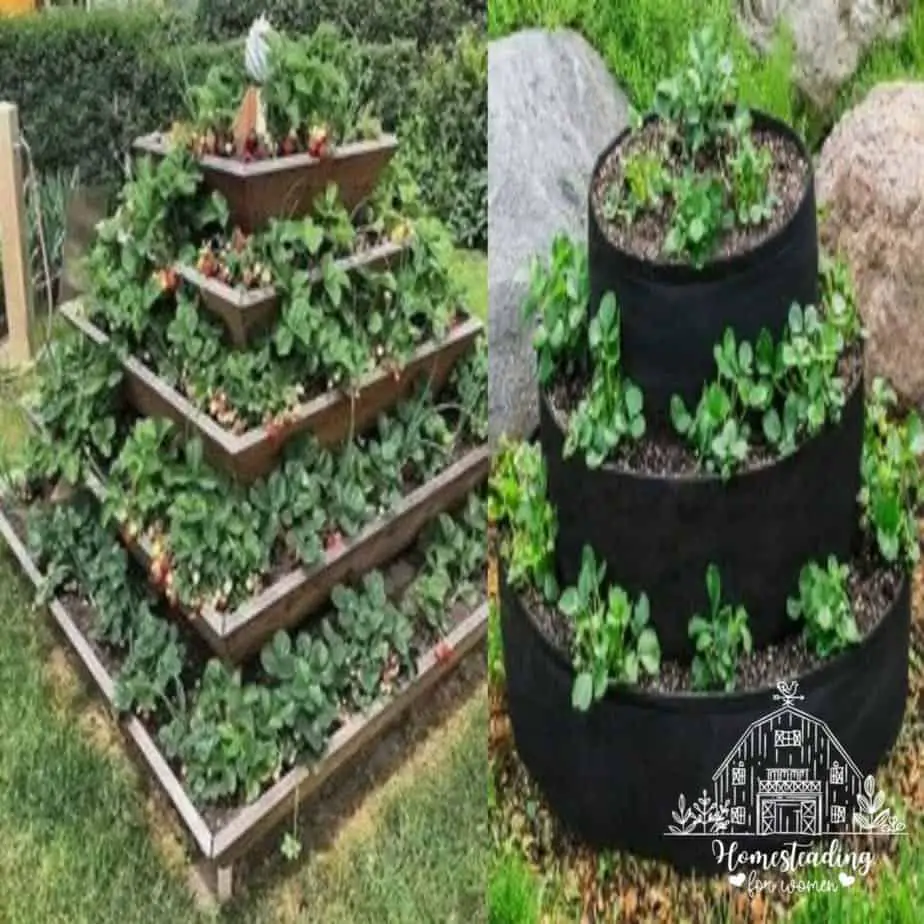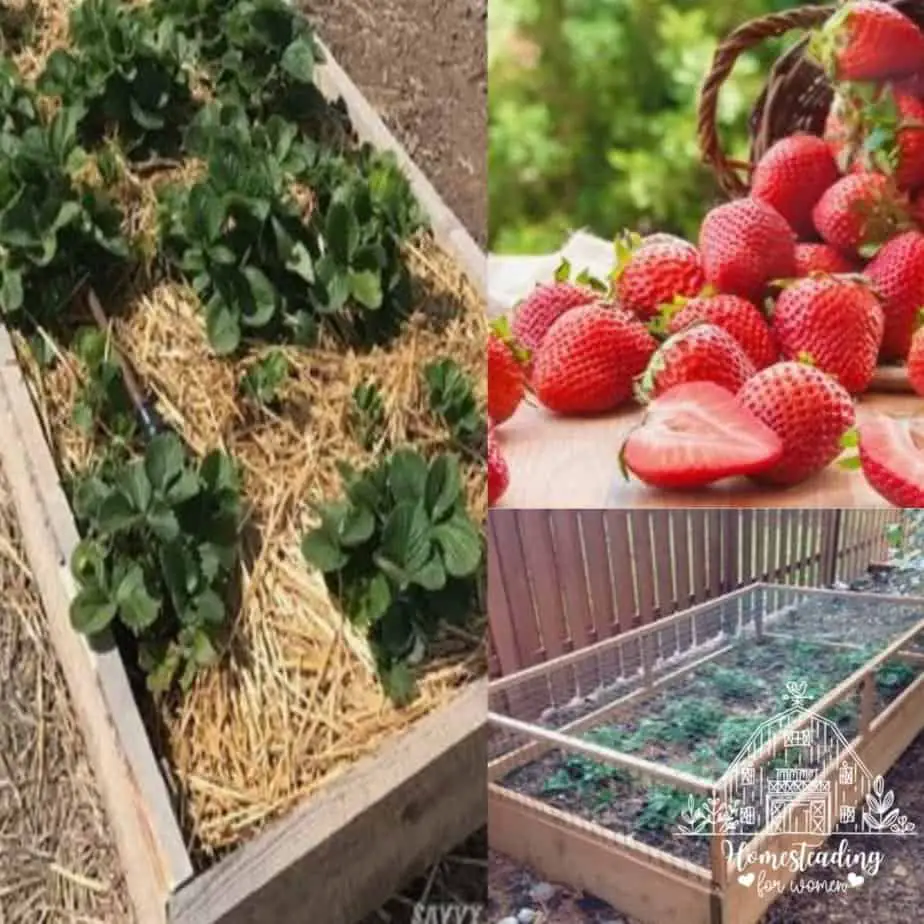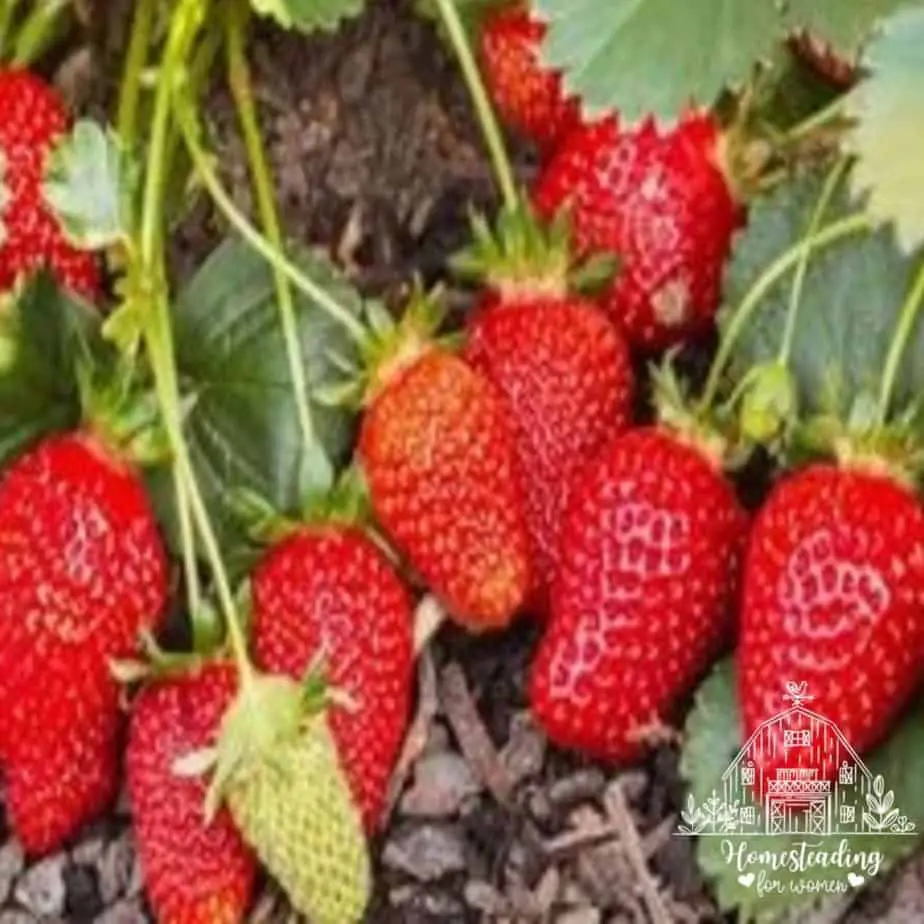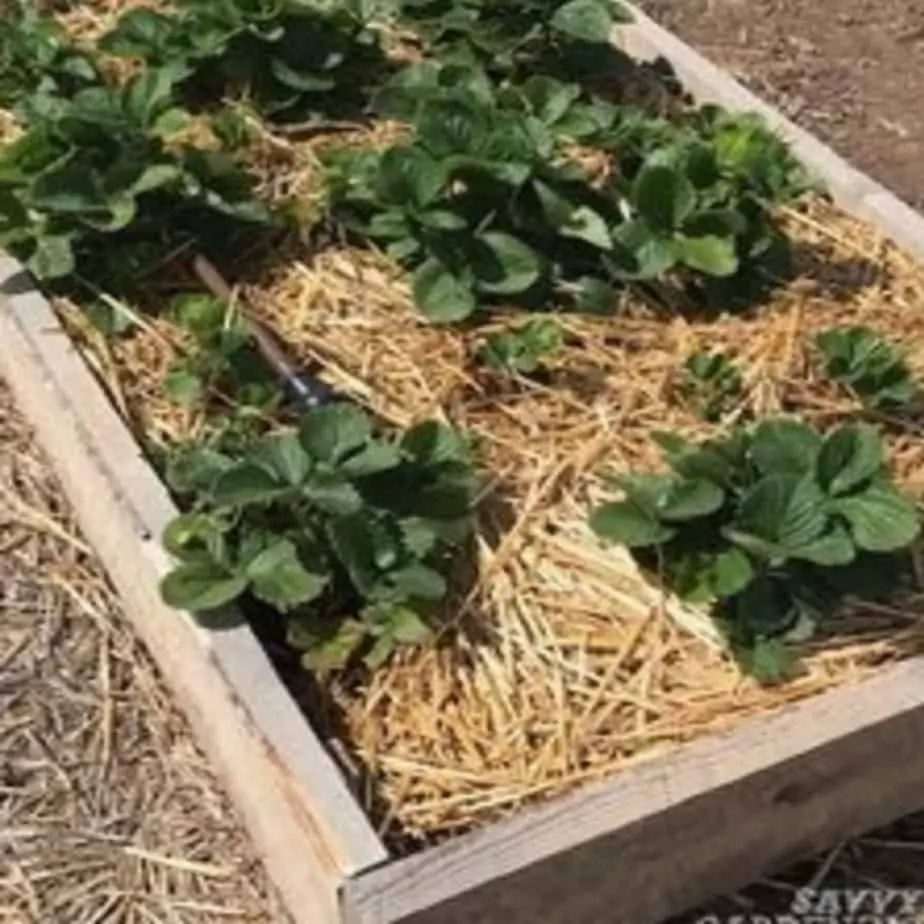Welcome to Homesteading For Women – we hope you enjoy all our tips and tricks for homestead women! Please note that we use affiliate links and ads to generate income at no cost to you.
Raised beds for strawberry plants. Is it really better to grow them that way? My back thinks so!
Let’s face it! Growing strawberries in raised beds can be a rewarding experience, offering several benefits for both the plants and the gardener.

A lady said this to me the other day. “Strawberries like water but not wet feet.” Raised beds enhance drainage, which strawberries crave, and you no longer killing my back doing the weeding. I do love raised beds for gardening.
With a raised platform, your strawberry plants gain a dedicated space that’s tailored to their growing needs, potentially leading to a bountiful harvest of those sweet, juicy fruits.
Setting up raised beds for strawberry plants isn’t complicated. You’ll want to pick a sunny spot because strawberries thrive with plenty of light. The soil in raised beds warms up faster come spring, giving you a head start on the growing season.

Welcome to Homesteading For Women – we hope you enjoy all our tips and tricks for homestead women! Please note that we use affiliate links and ads to generate income at no cost to you.
Plus, you can fill your beds with the perfect soil blend to ensure strong, healthy plants. I heard that strawberries love compost. I’m going to use some of my compost pile this year for my new strawberry patch. Yay!
One of the great things about raised beds is that you’re in control of the growing conditions. By elevating your strawberries, you reduce the risk of soil-borne diseases, and pests find it tougher to attack your precious berries.
It’s all about creating an ideal environment for strawberries to flourish. Just imagine plucking ripe, red strawberries right from your backyard, grown in a bed that you set up and nurtured. I can see it now!
Planning Your Raised Beds For Strawberry Plants
Before you get your hands dirty, pinpoint the perfect spot for your strawberries and figure out the dimensions and materials for your raised bed.
Choosing the Right Location
Your strawberry plants are sun lovers. Aim for a location that gets at least 6 to 8 hours of sunlight each day. Also, ensure good air circulation and efficient drainage. A spot that’s higher than the surrounding ground can help avoid water logging after a downpour.
Determining the Size and Shape
Strawberries aren’t picky about space but plan for a bed that’s at least 8 inches deep to accommodate their roots. A typical width is about 3 to 4 feet—this allows you to reach the center without stepping into the bed.
The length can be as long as you desire or have room for. Here’s a simple chart to help you visualize a practical layout:
| Dimensions | Purpose |
| Length: Flexible | Caters to available space and number of plants |
| Width: Max 4ft | Ensures reachability without stepping inside |
| Depth: Min 8in | Suits strawberry root systems |

Selecting Materials for Construction
Now let’s talk shop—materials. Untreated cedar is a popular choice; it’s durable and safe for edible plants.
Though pressure-treated wood was once a concern, newer treatments are considered safe for food gardens. If wood isn’t your thing, concrete blocks are a sturdy alternative.
Avoid materials that could leach harmful chemicals into your soil and ultimately, your strawberries.
Soil Preparation and Composition
Strawberries thrive in well-prepared soil that’s rich in organic matter. For your berry success, focusing on soil mix and health is key.
Creating the Perfect Soil Mix
For your strawberries, the right soil mix will make a world of difference. You want a mix that holds enough moisture yet drains well. Here’s how to make it:
- Topsoil: Start with high-quality topsoil as your base; it’s where your plants will mostly spread their roots.
- Compost: Mix in plenty of compost—it’s loaded with nutrients and improves soil structure. Woohoo!
- Organic Matter: Add additional organic matter, such as aged manure or leaf mold; this will help the soil retain moisture and support a thriving microbial ecosystem. One lady said she puts dried leaves in the bottom of her raised bed and that works out really well for her.
Strive for a pH between 5.5 and 6.8; this slightly acidic environment is ideal for strawberries. If you’re working with heavy clay soil, incorporate sand or perlite to improve drainage. A loamy soil composition—part sand, silt, and clay—is the gold standard; it’s fertile and has excellent drainage properties.
Maintaining Soil Health
- pH Testing: Regularly check the soil pH with a test kit to ensure it remains slightly acidic.
- Organic Matter: Consistently amend your soil with organic matter every season to replenish nutrients and maintain soil structure.
- Mulching: Use mulch to conserve moisture, keep roots cool, and reduce weed growth.
Remember, soil health is an ongoing effort. Continuously nurture it, and your strawberry plants will thank you with an abundance of sweet fruit.

Planting and Arranging Strawberry Plants
Now that you’ve created your raised beds for strawberry plants, knowing the right depth and spacing is crucial for healthy growth. Also, understanding how to effectively plant runners will ensure you get a bountiful harvest.
Spacing and Depth for Planting
For optimal growth, plant your strawberry plants about 12-18 inches apart in rows spaced 24-30 inches from each other. Each plant’s roots should be spread out in the planting hole, and the crown should be at soil level. Planting depth is key: too deep and the crowns may rot; too shallow and the roots may dry out. Here’s a simple guide for planting:
- June-bearing varieties: Plant in early spring.
- Everbearing and day-neutral varieties: These can be planted in spring or late summer.
Follow this table for a quick reference on planting:
| Strawberry Variety | Planting Depth | Row Spacing | Plant Spacing |
| June-bearing | June-bearing | 24-30 inches | 12-18 inches |
| Everbearing | Just below the soil surface | 24-30 inches | 12-18 inches |
| Day-neutral | Just below the soil surface | 24-30 inches | 12-18 inches |
Strategies for Planting Runners
Strawberry plants produce runners, which are long, vine-like shoots with potential baby plants at the ends. Here’s what you need to know about planting runners:
- Use runners for propagation: Pin down runners in the soil to let them root and grow into new strawberry plants.
- Trim excess runners: Keep your beds tidy and your plants’ energy focused by trimming excess runners, leaving only a few per plant to grow as replacements.
Once planted, the baby plants from these runners can use the space efficiently in your raised bed, following the same spacing guidelines as the original plants. Remember to keep the soil moist and to mulch around the plants to help retain moisture and suppress weeds.
Pro Tip: Don’t overfill the beds with plants. One mother plant will send out runners “babies” that will produce. Every three years cull the mother plants.
Irrigation and Watering Techniques
Proper irrigation ensures your strawberry plants get just the right amount of water without waste or over-saturation. Remember to balance moisture levels to encourage healthy growth and keep those tasty strawberries coming.
Setting Up an Efficient Watering System
When you’re setting up, go for a drip irrigation system or soaker hoses. These deliver water directly to the top of the soil, not down in the roots, reducing evaporation and minimizing the wetting of leaves, which can lead to fungal diseases.
Remember strawberries love water but not wet feet.
Position the watering lines strategically to cover all your plants evenly. Here’s a simple guide to get you started:
- Place drip lines or soaker hoses along the length of your raised bed.
- Space them about 12-18 inches apart to ensure even coverage.
- Connect the lines to a water source with a pressure regulator to maintain consistent water flow.
- Consider using a timer to automate the watering schedule—early morning is usually best.
Raised Beds For Strawberry Plants Watering Issues
Your strawberry plants love water, but too much can cause problems. Aim to keep the soil moist but not waterlogged. Over-watering can lead to poor root health and increase the risk of disease. Layering mulch around your plants helps retain moisture, control weeds, and prevent water from splashing onto the foliage, which can spread weed seeds or disease.
- Mulch with straw or pine needles to help maintain soil moisture.
- Black plastic is another option. It can warm the soil, discourage weeds, and promote faster growth, especially if you’re in a cooler climate.
- Regularly check the soil moisture; it should be moist to a depth of about one inch.
- Ensure your raised bed has adequate drainage to prevent waterlogging.

Raised Beds For Strawberry Plants -Caring Throughout the Seasons
To ensure a bountiful harvest of strawberries, it’s crucial to tend to your raised beds with season-specific care. Throughout the varying temperatures and conditions of the year, your strawberry plants require different types of attention to thrive.
Spring Care and Preparation
As spring arrives, it’s time to wake your strawberry plants up from their winter slumber. Begin by removing any dead leaves and weeds that have accumulated to prevent disease and pests. Next, apply a balanced 10-10-10 fertilizer to give your plants a boost of nutrients. If you covered your strawberries with straw or other mulch for winter protection, gradually remove it as the weather warms.
- Pruning: Snip off any brown or dead foliage.
- Weeding: Keep the bed weed-free to reduce competition.
- Fertilizing: Use a balanced fertilizer before plants fully leaf out.
Managing Plants during the Growing Season
During the growing season, consistent care is key. Water your strawberries regularly, aiming for at least an inch per week, to ensure deep watering. Keep an eye out for weeds; swiftly removing them helps maintain nutrient-rich soil for your plants.
- Mulching: Lay down straw or pine needles to deter weeds and retain soil moisture.
- Monitoring: Check plants for signs of pests or diseases.
As blossoms appear and fruits begin to form, consider installing bird netting to protect your crop. Harvest ripe strawberries in the morning and handle them gently to avoid bruising.
Pro Tip: Conventional wisdom says to pinch off all blossoms the first year to allow for better root growth and stronger plants.

Fall and Winter Considerations
Come fall, preparation for cooler weather is essential. Once the harvest is over, it’s time to focus on preparing your plants for winter. This might include cutting back foliage and thinning overcrowded plants.
- Pruning: Remove old leaves after harvest to encourage air circulation.
- Mulching: Apply a thick layer of straw or other mulch after the first freeze to protect plants.
- Winterizing: Ensure plants are well-watered before the ground freezes.
By mulching, you not only safeguard the plants against freeze but also suppress weed growth and enhance soil health. When the ground starts to freeze, add extra mulch to shield your strawberries from fluctuating winter temperatures.
Maximizing Yield and Ensuring Quality
To get the most out of your strawberry plants, focusing on proper fertilization and understanding the nuances of different strawberry varieties are crucial. Balanced nutrients and the right variety selection can lead to a bountiful harvest of flavorful fruits.
Fertilization and Nutrient Management
Your strawberry plants need the right nutrients at the right times to flourish. Start by incorporating a slow-release fertilizer into your raised beds before planting. This gives your strawberries a steady supply of nutrients throughout the growing season.
June-bearing varieties like ‘Jewel’, fertilize in the early spring as they start to grow. With everbearing and day-neutral varieties, such as ‘Albion’, additional fertilizing after the first harvest can encourage more fruiting.
| Growth Stage | Fertilizer Type | Frequency |
| Pre-planting | Slow-release | Once, at planting |
| Early Spring | Balanced blend (10-10-10) | Every 4-6 weeks |
| Post-harvest (Everbearing/Day-neutral) | Balanced blend (10-10-10) | As needed |

Understanding Different Strawberry Varieties
The strawberry variety you choose directly affects yield, taste, and the length of your growing season.
June-bearing strawberries yield a large crop over a few weeks in early summer, perfect for making jams or hosting a pick-your-own event. They’re famous for their big, sweet fruits.
Everbearing varieties produce two to three smaller harvests throughout the growing season, allowing you to enjoy fresh strawberries for a longer period.
Day-neutral varieties, like ‘Albion’, adapt to a wide range of growing conditions and can yield strawberries continuously throughout the season, which is great for consistent, homegrown taste and enjoyment.
Pest and Disease Management
Effective pest and disease management ensures your strawberry plants remain healthy and productive. Keeping an eye out for common issues and using organic methods can protect your plants without reliance on harsh chemicals.
Identifying Common Threats
Pests: Your strawberry plants may attract a range of pests, including slugs, aphids, and spider mites. Regularly inspect your plants for these critters, as they can quickly damage foliage and fruit.
- Slugs and Snails: Look for irregular holes in the leaves and shiny slime trails.
- Aphids: These tiny insects cluster on the undersides of leaves and can spread diseases.
- Spider Mites: Fine webs and speckled leaves are telltale signs.
Diseases: Fungi diseases like powdery mildew and botrytis, or gray mold, are common. Also, be vigilant about root rot, signaled by wilted leaves and discolored roots.
- Powdery Mildew: White powdery spots appear on leaves and stems.
- Gray Mold (Botrytis): Watch for fuzzy gray growth on berries and flowers.
Weeds: They compete for resources and can harbor pests and diseases. Consistent weed control is necessary to maintain plant health.
Organic Remedies and Preventative Measures
Organic Matter: Enrich your soil with compost to bolster plant vigor, making it less susceptible to pests and diseases.
Mulching: A layer of straw mulch helps regulate soil moisture, preventing root rot, and can deter slugs.
- Apply mulch around your plants but not directly against stems to maintain good air circulation.
Companion Plants: Planting borage or marigolds nearby may deter unwanted insects while attracting beneficial ones.
Geo-Textile Fabric: This can be used as a barrier against weeds. It allows water and air to reach the soil while keeping weeds at bay, simplifying your weed control efforts.
Regular Maintenance: Prune your plants to keep them from overcrowding, which improves air circulation, reduces humidity, and minimizes fungal disease risks.
Using these organic strategies to manage pests and diseases will help keep your strawberry beds thriving.
You Might Also Like To Read:
The Best Time To Pick Wild Blackberries
Homemade Hummingbird Nectar Recipe
7 Tips To Growing Tomatoes In Containers

Additional Tips for Home Gardeners
When prepping your raised garden beds for strawberries, you’ll want to keep in mind a few helpful techniques to optimize your gardening success:
- Choosing Seeds: Choose strawberry seeds that will thrive in your local climate. Consider your area’s temperature range and day length when picking varieties.
- Weeding: Keep weeds at bay by starting with a clean bed. Use layers of newspaper or cardboard at the base of your raised bed to suppress weed seeds. Over time, these materials will decompose and enrich your soil.
- Maximizing Space: If you’re limited on space, remember that raised beds offer efficient use of vertical space. You can plant strawberries closer together in a raised bed compared to a traditional garden plot.
- Ideal Conditions: Make sure your garden beds get enough sunlight. Strawberries love full sun but can tolerate partial shade—aim for at least six hours of sun a day.
- Soil Health: Amend your soil with rich compost to give your strawberry plants a boost. Healthy soil promotes vigorous growth and yields.
- Watering and Tools: Consistent moisture is key, but don’t overwater. Consider drip irrigation tools to maintain even soil moisture and save time.
- Regular Maintenance: Inspect your plants regularly and remove any dead foliage to keep your strawberry plants healthy and productive.
By following these steps you should have all the information you need and start building your raised beds for strawberry plants this coming year. You will be so happy you did this, I promise!
- Caring for Aging Parents: What I’ve Learned the Hard Way (And Why I’m Planning Ahead Now) - August 4, 2025
- 7 Must Get Beginner Herbal Books For Your Library - July 30, 2025
- What to Have Ready When the Power Goes Out (Even at 6AM!) - July 27, 2025

